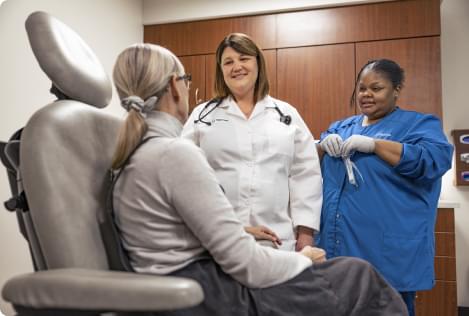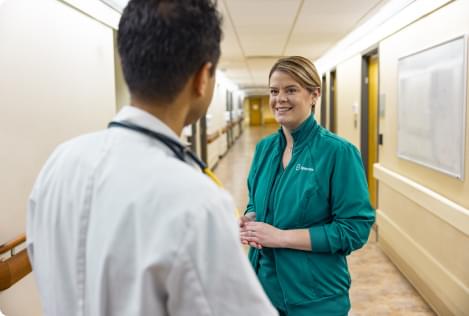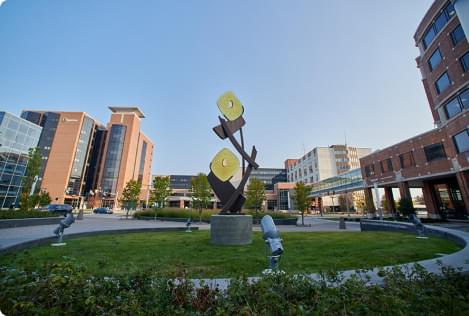Overview
Trichinosis (trik-ih-NO-sis) is a type of infection caused by a roundworm parasite. Roundworm parasites use a host body to live and breed more roundworms. These parasites, also called trichinella worms, infect animals such as deer, bears, moose, walruses, wild boars and pigs.
The infection, also called trichinellosis (trik-ih-nuh-LOW-sis), spreads when animals eat the young forms of the roundworm in raw meat. The young forms are called larvae.
People may get trichinosis when they eat infected meat that hasn't been cooked enough. The larvae take a few weeks to grow into adult worms in the small intestine. The adult worms make more larvae that travel through the bloodstream. They then make a home in muscle tissue.
Trichinosis happens throughout the world. There's medicine to treat adult worms that cause the condition. But not everyone needs medicine. Prevent trichinosis by making sure food is cooked to the recommended temperature.
Symptoms
Symptoms of trichinosis infection and how bad they are can vary. They depend on the number of larvae eaten in the infected meat. Symptoms can happen with a larger number of parasites in the body. Symptoms sometimes get worse as the roundworm larvae travel through the body.
No symptoms
Trichinosis with only a small number of parasites in the body may not cause symptoms.
Early symptoms
People eat meat infected with roundworm larvae in tiny sacks, called cysts, that hold the parasite. During digestion, the larvae are released. The larvae then enter the wall of the small intestine. There they grow into adult worms and mate.
Digestive symptoms can begin 1 to 2 days after infection. At this stage, you may have:
- Loose stools.
- Belly pain.
- Tiredness.
- Upset stomach and vomiting.
Later symptoms
About a week after infection, the adult female worms make larvae. The larvae go through the wall of the intestine and enter the bloodstream. They travel around the body and bury themselves in muscle tissue.
Each larva either forms a cyst around itself or buries itself in the muscle without a cyst. The larvae can live for months to years inside the muscle tissue.
Symptoms caused by having roundworms in muscle tissue most often start 2 to 8 weeks after infection. Symptoms include:
- High fever and chills.
- Muscle pain and tenderness.
- Aching joints.
- Swelling of the eyelids or face.
- Weakness.
- Headache.
- Sensitivity to light.
- Eye pain or pink eye, also called conjunctivitis.
- Itchy skin.
Having many parasites can cause bad muscle pain and weakness. This can make it hard to move, breathe and speak.
Symptoms may last for several months. But they ease when the larvae form cysts. Even after the infection is gone, tiredness, mild pain, and weakness may last for months or years.
When to see a doctor
If you have mild trichinosis with no symptoms, you might not need medical care. If you have digestive problems or muscle pain and swelling about a week after eating pork or wild-animal meat, talk with your healthcare professional.
Causes
People get trichinosis when they eat raw or undercooked meat that is infected with the larvae of a trichinella roundworm parasite. You can't get the infection from another person or give it to another person.
Wild animals are infected when they feed on other infected animals. Domestic animals could be infected by their feed or contact with meat scraps.
In the United States, pigs have become a less common source of infection due to better management of pork feed and products. But pigs raised or killed on farms that are not commercial may be infected. Wild-animal meat is the source of most trichinosis in the U.S.
You can't get trichinosis from beef most of the time because cows don't eat meat. But some trichinosis in people has been linked to eating beef that was mixed with infected pork. You also can get trichinosis when beef or other meat is ground in a grinder that has processed infected meat.
Risk factors
Eating raw or undercooked food is the main risk factor for trichinosis. Food also can be infected by grinders or other equipment. The risk may be higher for people who eat meat from wild animals. Trichinosis risk also may be higher from animals raised and processed outside of a commercial facility.
Complications
Complications linked to trichinosis are rare. But if many roundworm larvae move through the body to muscle tissue in and around organs, this may cause harmful complications. Some complications may be fatal.
Complications may include pain and swelling, also called inflammation, of the:
- Muscle layer of the heart wall. This condition is myocarditis.
- Brain. This condition is encephalitis.
- Tissue layer that protects the brain and spinal cord. This condition is meningitis.
- Lungs. This condition is pneumonitis.
Prevention
The best way to prevent trichinosis is to cook food well. Follow these tips:
- Don't eat meat that's raw or not cooked to a safe temperature. Be sure to cook cuts of meat until brown. Cook pork and meat from wild animals to 160 degrees Fahrenheit (71 degrees Celsius) at the center. Use a meat thermometer to make sure the meat is cooked well enough.
- Freeze pork. Freezing pork that is less than 6 inches thick at 5 degrees Fahrenheit (minus 15 degrees Celsius) for three weeks kills the roundworm parasites. But roundworm parasites in wild-animal meat won't die by freezing, even over a long period.
- Know that other ways of processing meat don't always kill parasites. If meat is infected, smoking, curing and pickling won't make it safe to eat. Neither will cooking it in a microwave.
- Clean meat grinders well. If you grind your own meat, make sure to clean the grinder well after each use.
- Wash your hands. After handling raw meat, wash your hands well with soap and water for 20 seconds. This can prevent spreading parasites to other food.
Diagnosis
Your healthcare professional can diagnose trichinosis by asking about your symptoms and doing a physical exam. Tell your healthcare professional if you've eaten meat that was raw or not cooked to a safe temperature.
You also might have these tests:
- Blood tests. A blood sample can show signs of trichinosis. These signs include a high number of white blood cells called eosinophils. Or, after a few weeks, your blood might have formed antibodies against the parasite.
- Muscle biopsy. A blood test most often is enough to make a diagnosis. But your healthcare professional also might do a muscle biopsy. This involves removing a small piece of muscle to study under a microscope for roundworm larvae.
Treatment
Trichinosis most often gets better on its own. If you have a mild or moderate number of larvae, most symptoms go away within a few months. But you may have tiredness, mild pain, weakness and loose stools for months or years. Infection with a lot of larvae can cause worse symptoms that need treatment right away.
Your healthcare professional may prescribe different medicines based on what you need.
Antiparasitic medicine
This is the first line of treatment for trichinosis. Early on, albendazole or mebendazole (Emverm) can kill the worms and larvae in the small intestine. Side effects may include upset stomach, vomiting, loose stools and stomach pain.
If the larvae have buried themselves in muscle tissues, the antiparasitic medicines may not kill all the parasites. But you may take an antiparasitic medicine if you have brain, heart or lung pain and swelling, called inflammation, due to larvae in these organs.
Pain relievers
After the larvae are in the muscles, your healthcare professional may prescribe pain relievers to help ease muscle aches and inflammation. Over time, the larvae cysts in the muscles tend to harden into calcium, called calcify. Then the larvae die, and the muscle aches and weakness most often go away.
Steroid medicine
Sometimes trichinosis can cause an allergic reaction. This may happen when the parasite enters muscle tissue or when dead or dying larvae release chemicals in the muscle tissue. A steroid medicine may control pain and swelling.
Preparing for your appointment
You're likely to start by seeing your family healthcare professional. Sometimes, you may see an infectious disease specialist.
Here's some information to help you get ready for your appointment.
What you can do
Make a list of:
- Your symptoms, and when they began. Include those that don't seem linked to the reason you scheduled the appointment.
- Key personal information. Include major stresses or recent life changes. Also list if you've eaten any raw or rare pork or wild-animal meat lately.
- All medicines, vitamins, herbs and supplements you take, including dosages.
- Questions to ask your healthcare team.
For trichinosis, some questions to ask include:
- What is likely causing my symptoms or condition?
- What are other possible causes?
- What tests do I need?
- Is my condition likely to clear up or last?
- What treatments are there?
- Are there brochures or other printed material I can have? What websites do you suggest?
Be sure to ask all the questions you have.
What to expect from your doctor
Your healthcare team may ask you questions, such as:
- Have you eaten raw or rare pork or wild-animal meat lately?
- Have your symptoms stayed with you or do they come and go?
- How bad are your symptoms?
- What, if anything, makes your symptoms better?
- What, if anything, makes your symptoms worse?
© 1998-2025 Mayo Foundation for Medical Education and Research (MFMER). All rights reserved. Terms of Use


